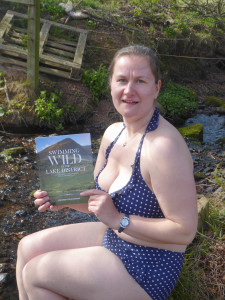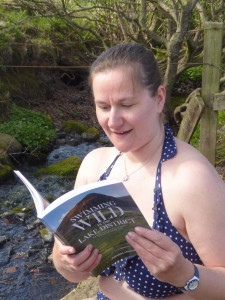Suzanna’s book starts on a personal note, recounting an experience that most wild swimmers can identify with. We’ve all had the inevitable conversation with a loved one who worries about the safety of our hobby, which quite often leads on to the debate about why anyone would want to plunge themselves into cold water in the name of fun in the first place.
While most of these conversations end in a resigned shrug when they happen to me; for Suzanna, it has resulted in a book, and a lovely one at that. It’s clear that her father has been an integral part of her enjoyment of nature. The advice for such loved ones to stand on the shore with a throw rope just in case is great for anyone looking to reassure friends and family who watch from the banks of a lake while they swim.
She sets out her credentials as a hill walker and the transferable skills that can be applied to wild swimming. Then Suzanna starts to outline her own personal story of wild swimming, how she started and where it has taken her. As with most wild swimmers, her tentative swims have turned into a passion, but she has taken it further to become a business, and now a book.
Before getting into the detailed sections exploring the most beautiful wild swimming spots in the larger lakes, Suzanna offers plenty of advice. This ranges from tips on safety and how to assess swimming locations, right the way through to the best kit to invest in if you’re planning on taking the plunge in the wild fairly regularly. All useful and a good overview of areas to consider. Of course, wild swimming is not just about getting a bit of exercise, but all to do with enjoying nature at its finest. The section on why lakes are certain colours is fascinating and it’s great to take a dive into the subject.
Swimming in the Lake District also comes with an added responsibility and that is not to cross-contaminate alien species of non-native plants and organisms across different bodies of water. This has become a big problem in many of the area’s lakes and Suzanna highlights the steps swimmers should take not to increase the issue. Some lakes have been more adversely affected than others, so if you’re going to swim in multiple lakes, tick off the cleanest ones first. Then follow the Check, Clean and Dry protocol.
Each of the 14 lake sections outlined in the book is made up of a number of swimming locations, showing specific spots where you can take a dip. A handy information panel shows everything from the average depth to the inflows and outflows, and there’s also very useful notes on getting to the right areas and where to enjoy refreshments. Where it’s worth noting additional factors, like boat traffic, this is also included.
What’s so lovely about Suzanna’s descriptions of the lakes is how intimately she knows each one. In the introduction to Rydal Water, she talks about two particularly vicious swans and the opportunity to see otters in the southern part of the water. It’s this local knowledge that makes Swimming Wild in the Lake District more than just a resource, but a lovely form of inspiration for future swimming expeditions. Rydal Water holds a particular place in my heart and I crowned it my best swim of 2019.
Complete with vivid pictures, maps and additional information, Suzanna has produced a book that will surely inform many wild swims in the Lake District for years to come.
A copy of the book was provided by the publisher to review










Leave a Reply